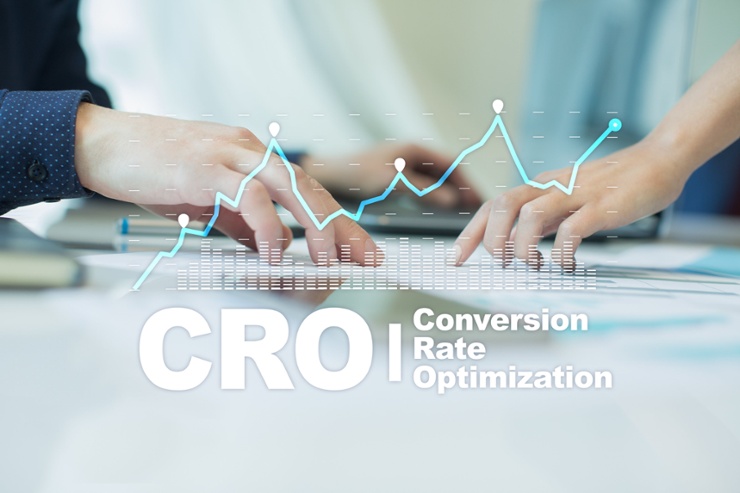
Yusuf Shurbaji
January 24, 2023
|
13
min read
If you conduct business online and have a website, you have a conversion rate. This rate can often be attributed to a hard number, and it fundamentally represents how effectively your website accomplishes the goals of your business.
Your conversion rate is the rate at which visitors to your website perform a desired action. Whether that is subscriptions, customer testimonials, consumers clicking add to cart, or even just going beyond your website landing page, your conversion rate is essential knowledge.
With this knowledge comes the opportunity to optimize your website and increase the rate at which those desired actions occur.


The online environment is dynamic and highly malleable. This enables you to make extensive impacts on your website with a degree of ease unmatched in the brick-and-mortar world of business. However, this flexibility also lends itself to a highly competitive marketplace of ideas, goods, and services.
You are competing for an audience's attention with progressively lessening patience and willingness to engage with your offerings, and you must effectively command their attention. This reality underpins the critical nature of understanding and optimizing your conversion rate.
While the precise makeup of an individual’s desired outcomes for a website is highly variable, the conversion rate optimization (CRO) process has several crucial and steadfast elements.
A fitting analogy for the process of a website visitor completing a desired action on your site is their framing of that decision-making process or customer journey as a sales funnel.
What you have to offer serves as an inflection point, an initial point of connection that leads a visitor to your website into the sales funnel. In order to lead that consumer through the sales funnel to the consumer behavior and action you desire, your website must keep their attention.
With optimization, you are empowering a site visitor to make your desired conversion, whether that’s clicking on a CTA or filling out a form on your homepage. You can design the sales funnel, but your customer has to decide to continue through it.
Effective CRO culminates in a clearly delineable process. You can break it down into steps. With clearly defined steps in your strategy, you have a procedure that can be repeated.
Depending on the nature of your business, you may have a singular desired outcome for your website — but it is also likely that you will have multiple CRO goals. Before you begin to optimize your conversion rate, it’s important to identify your goals.
An important question to answer while you’re identifying your conversion goal is what kind of website you have.
This is a website that functions as an online equivalent of a physical store. You are offering products to the people who visit your site.
The most consequential eCommerce conversion to consider is compelling someone to place an order on your site.
Instead of selling a product, this type of website functions as a mechanism to convince site visitors to hire you for your services or expertise. This is the basic function of a website for businesses such as consulting firms and law firms.
In this context, your website is trying to establish your business’s legitimacy and viability amongst the variety of options in your marketplace. The desired conversion occurs in the physical world and is accounted for digitally when a site visitor is compelled to reach out upon viewing your website.
The function of this website is not transactional like a lead generation or eCommerce website. The desired conversion at hand is page views, and the revenue earned comes from on-site advertising.
Conversions in this type of website are typically more difficult to quantify because your success is evaluated within the context of your advertisers’ success. The simplest and most consequential conversions include factors such as how much time visitors spend on the website and return visitors to your website.
Another desired – and perhaps more tangible — conversion for this category of website could be subscriptions.
This type of website seeks to increase awareness of a brand within a given market. Conversions are not easily discernible among websites that fit into a clearly defined category. This makes your website conversion rate a little trickier to pin down, although analytics tools may be able to help you out.
As with brand websites, conversions are similarly difficult to define for social media websites. The basic function at hand is cultivating a network or community of people.
Your most consequential conversions are highly variable and will hinge on what you would ultimately like to accomplish by connecting people online.
Once you have identified your goal conversion, it’s time to quantify them.
Thinking back to the idea of a sales funnel, it’s important to think about each step that leads to that desired conversion. Each step is an opportunity to move a customer further along your sales funnel — or for the customer to move away from that desired course of action.
It can be helpful to frame your analysis with clearly defined parameters:
Within a given period of time, divide the total number of conversions that occurred by the number of visitors to your web page or site to get an average conversion rate.
Think of your website landing page, product page, and tools like your “add to cart” button as necessary micro conversions and offramps within your sales funnel.

There are multiple parameters you have to define if you’re going to get useful information from your conversion optimization. One of the biggest is the time in which you will perform the analysis.
From there, you will look for different kinds of desired actions that should happen in that time, depending on the nature of your business.
Even once you figure out these basic parameters, you’ll need to place them into a useful context:
Doing this effectively and precisely will help you see your conversion rate as a direct reflection of more specific changes instead of collective changes.
For instance, factors such as total order value, frequently purchased together, or customer demographics for specific items could all provide useful insight that speaks to what you are doing right or wrong in your CRO strategy.
Another useful tool for contextual insight on metrics and proving results in CRO marketing efforts is A/B testing, also referred to as “A/B/n testing” or “split testing.” This sort of testing is a highly useful CRO function.
Realizing the impact of your CRO process can quickly become vague if you don’t exercise restraint and precision in your strategy and CRO process.
It’s easy to see this happen when too many changes are made at the same time — even if the changes are small.
When you implement drastic or widescale changes, you run the risk of losing track of which elements are having a positive impact on your audience and which elements are detracting from your CRO goals.
Small and slowly implemented changes will allow you to see what is effective and enable larger, more consequential change once you have a grasp on what’s been working. It is important for each business to find a balance between both approaches, depending on their appetite to “move fast and break things” or “move slowly and certainly.”
Avoid frustration and trust the process of steady and incremental change. If you are unhappy with your conversion rate, the inclination may be strong to make large-scale changes or perhaps even start over from scratch. In a few years, most find themselves in the same exact situation, wondering why the last "overhaul" didn't solve their business's problems.
It is helpful to frame your conversion rate optimization efforts within a grander context. That context is a concept mentioned above: that your potential customers, clients, or subscribers are entering into a sales funnel when your business attracts their interest.
This concept derives its name from the idea that your business casts a wide net constituting the top of the funnel. From that wide audience, your digital marketing strategy (and your CRO efforts) hone in on the individuals most likely to be interested in your business.
That pool of people shrinks as your efforts become more tailored at each sales funnel stage.
You can think of this customer journey as having five distinct and increasingly desirable stages or pools of people that develop: awareness, consideration, conversion, loyalty, and advocacy.
The makeup of these pools is dictated by how you are deploying and tweaking your CRO tools to respond to user behavior.
This is your audience at its broadest extent. In a very overarching sense, look to define the identity of your target audience.
What characteristics make consumers a fit for your offerings? Once you make that decision, you can begin your efforts in inbound and/or outbound marketing strategy.
Inbound marketing seeks to pull consumers to you, while outbound marketing seeks to push your message out to consumers. In the context of conversion rate optimization strategy, inbound marketing is typically much more feasible and less expensive given the sheer amount of content on the internet.
This stage in the sales funnel consists of consumers actively evaluating whether they would like to complete the action you desire. The micro-conversions that culminate in the conversion you ultimately want to happen can come into play here in the form of leads.
These leads may take the form of a subscription to an email list, return visits to your website landing page, or in the case of a business such as a consulting or law firm, the micro conversion may be a formal request for information.
In this phase, the CRO strategy should be focused on educating consumers about why you are the best choice for them within the marketplace.
This is where the overarching or macro conversion you ultimately want to happen occurs. You could consider this the most difficult stage in the sales funnel because mere interest and non-monetary investment become tangible commitments.
This is also where the tracking of micro-conversions becomes paramount. In the context of an eCommerce website, a key micro-conversion to track would be individuals who add items to their shopping cart but do not complete a purchase. This might indicate a checkout process that isn’t streamlined well, or your customer could be reacting to elements like shipping time or shipping costs.
In scenarios like this, your best course of action is to change any possibilities that may be the issue and see how those alterations affect the conversion rate for that micro-conversion.
At this stage in the sales funnel, you are considering how you can impact customers who have already completed a desired macro conversion. Your ultimate goal is the retention of this group.
Functionally and strategically, this group of people could be separated out into a conversion funnel model of their own. The dynamics at play in the previous stages are not important in the way they are to potential customers.
Your CRO strategy and marketing strategy for these individuals should revolve around fostering loyalty. This could take the form of efforts such as loyalty programs that provide rewards for repeat consumers, email marketing, or newsletters.
When you have developed a solid base of loyal individuals, you can turn your attention to the prospect of these individuals advocating for your business to others.
Depending on the nature of your business, your focus could very well be most effectively directed at getting your current customers or clients to recommend your business to potential customers, as opposed to attracting a new audience independently.

Conversion rate optimization (CRO), Search engine optimization (SEO), and user experience (UX) are interrelated but distinct kinds of strategies and techniques to increase an organization’s success in the digital environment.
The impacts conversion rate optimization can have on your business could be immense. You are most essentially building a better route to what your business ultimately desires. This is critical in the online environment, where your audience is much more fickle and easily distracted than they are in the brick-and-mortar world of business.
Regardless of the quality of what your business has to offer, your bottom line could be negatively impacted if you’re not taking CRO seriously.
Compare a website that has neglected conversion rate optimization to a poorly run brick-and-mortar store. Imagine you are looking for lunch in a strip mall, and there are two restaurants right next to each other.
One has the windows blacked out, the open sign is not lit up despite it being business hours, and the wait staff is nowhere to be seen when you poke your head in.
Perhaps the place next door has much worse food, but all of these basics are covered. The restaurant with the better food and shoddy presentation will likely miss out on your business — and these same tenets apply when considering the importance of CRO.
A core aspect of conversion rate optimization is that once you have developed your array of CRO tools, you can continually use them and improve upon them. This aspect of conversion rate optimization would be well taken as a call to action for your business.
The evolution of CRO tools could be a necessary byproduct of introducing new goods or services. Even if that is not the case, you are subject to the ever-evolving landscape of the internet and the changing tastes of potential customers and clients.
By investing in a CRO strategy, you are creating an infrastructure of CRO tools you can continually return to and alter to best suit your needs over time and frame your efforts in a customer-centric way.

Yusuf Shurbaji
Co-Founder & Managing Partner
Yusuf Shurbaji has over a decade of ecommerce growth experience. His past work includes building optimization departments & running experimentation inhouse and agency side for Dior, JCPenney, LVMH, American Precious Metals Exchange, Princess Polly, Built Brands, Ladder Sport, Maze Group, HelloFresh, Ledger, Blockchain.com, Kind Snacks, and other 9-figure brands. Yusuf is a Co-Founder of Prismfly, a conversion rate optimization agency focused on growing revenue and EBITDA for D2C ecommerce brands. Prismfly is the first CRO focused Shopify Plus certified agency and has seen triple digit growth the past 2 years.
Yusuf Shurbaji





